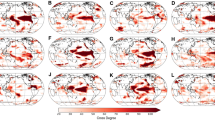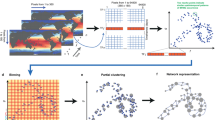Abstract
The interplay between extreme events in the Amazon’s precipitation and the anomaly in the temperature of the surrounding oceans is not fully understood, especially its causal relations. In this paper, we investigate the climatic interaction between these regions from 1999 until 2012 using modern tools of complex system science. We identify the time scale of the coupling quantitatively and unveil the non-stationary influence of the ocean’s temperature. The findings show consistently the distinctions between the coupling in the recent major extreme events in Amazonia, such as the two droughts that happened in 2005 and 2010 and the three floods during 1999, 2009 and 2012. Interestingly, the results also reveal the influence over the anomalous precipitation of Southwest Amazon has become increasingly lagged. The analysis can shed light on the underlying dynamics of the climate network system and consequently can improve predictions of extreme rainfall events.








Similar content being viewed by others
Notes
Negative value in the lag highlights the shifting back in the past of the driver’s sample window with respect to the POI.
References
Boers N, Barbosa HMJ, Bookhagen B, Marengo JA, Marwan N, Kurths J (2015a) Propagation of strong rainfall events from southeastern South America to the central Andes. J Clim 28(19):7641–7658
Boers N, Bookhagen B, Marengo J, Marwan N, von Storch JS, Kurths J (2015b) Extreme rainfall of the South American monsoon system: a dataset comparison using complex networks. J Clim 28(3):1031–1056
Boers N, Bookhagen B, Marwan N, Kurths J (2016) Spatiotemporal characteristics and synchronization of extreme rainfall in South America with focus on the Andes mountain range. Clim Dyn 46(1):601–617
Cox Peter M, Betts RA, Jones CD, Spall SA, Totterdell IJ (2000) Acceleration of global warming due to carbon-cycle feedbacks in a coupled climate model. Nature 408(6809):184–187. doi:10.1038/35041539
Eckmann J-P, Kamphorst SO, Ruelle D (1987) Recurrence plots of dynamical systems. EPL Europhys Lett 4(9):973
Lenton TM, Held H, Kriegler E, Hall JW, Lucht W, Rahmstorf S, Schellnhuber HJ (2008) Tipping elements in the earth’s climate system. Proc Natl Acad Sci 105(6):1786–1793
Marengo JA, Tomasella J, Alves LM, Soares WR, Rodriguez DA (2011) The drought of 2010 in the context of historical droughts in the Amazon region. Geophys Res Lett 38(12):L12703
Marengo JA, Espinoza JC (2015) Extreme seasonal droughts and floods in Amazonia: causes, trends and impacts. Int J Climatol 36(3):1033–1050
Nobre CA, Marengo JA, Seluchi ME, Cuartas LA, Alves LM (2016) Some characteristics and impacts of the drought and water crisis in Southeastern Brazil during 2014 and 2015. J Water Resour Protect 8(2):252–262
Stips A, Macias D, Coughlan C, Garcia-Gorriz E, San Liang X (2016) On the causal structure between CO2 and global temperature. Sci Rep 6:21691
Boers N, Donner RV, Bookhagen B, Kurths J (2015) Complex network analysis helps to identify impacts of the El Nino southern oscillation on moisture divergence in South America. Clim Dyn 45(3):619–632
Marengo JA, Nobre CA, Tomasella J, Oyama MD, Sampaio de Oliveira G, De Oliveira R, Camargo H, Alves LM, Brown IF (2008) The drought of Amazonia in 2005. J Clim 21(3):495–516. doi:10.1175/2007JCLI1600.1
Zeng N, Yoon JH, Marengo JA, Subramaniam A, Nobre CA, Mariotti A, Neelin JD (2008) Causes and impacts of the 2005 Amazon drought. Environ Res Lett 3(1):014002
Lewis SL, Brando PM, Phillips OL, van der Heijden GMF, Nepstad D (2011) The 2010 Amazon drought. Science 331(6017):554
Espinoza JC, Ronchail J, Guyot JL, Junquas C, Vauchel P, Lavado W, Drapeau G, Pombosa R (2011) Climate variability and extreme drought in the upper Solimões river (western Amazon basin): understanding the exceptional 2010 drought. Geophys Res Lett 38(13):L13406
Yoon JH (2016) Multi-model analysis of the atlantic influence on southern Amazon rainfall. Atmos Sci Lett 17(2):122–127
Andreoli RV, Ferreira de Souza RA, Kayano MT, Candido LA (2012) Seasonal anomalous rainfall in the central and eastern Amazon and associated anomalous oceanic and atmospheric patterns. Int J Climatol 32(8):1193–1205
Marengo JA, Borma LS, Rodriguez DA, Pinho P, Soares WR, Alves LM (2013) Recent extremes of drought and flooding in Amazonia: vulnerabilities and human adaptation. Am J Clim Change 2(2):87–96
Marengo JA, Tomasella J, Soares WR, Alves LM, Nobre CA (2011) Extreme climatic events in the Amazon basin. Theor Appl Climatol 107(1):73–85
Marengo JA, Alves LM, Soares WR, Rodriguez DA, Camargo H, Riveros MP, Pablo AD (2013) Two contrasting severe seasonal extremes in tropical South America in 2012: flood in Amazonia and drought in northeast Brazil. J Clim 26(22):9137–9154
Donges JF, Zou Y, Marwan N, Kurths J (2009) The backbone of the climate network. EPL Europhys Lett 87(4):48007
Espinoza JC, Ronchail J, Frappart F, Lavado W, Santini W, Guyot JL (2013) The major floods in the Amazonas river and tributaries (western Amazon basin) during the 1970–2012 period: a focus on the 2012 flood. J Hydrometeorol 14(3):1000–1008
Filizola N, Latrubesse EM, Fraizy P, Souza R, Guimarães V, Guyot JL (2014) Was the 2009 flood the most hazardous or the largest ever recorded in the Amazon? Geomorphology 215:99–105
Sena JA, De Deus LAB, Freitas MAV, Costa L (2012) Extreme events of droughts and floods in Amazonia: 2005 and 2009. Water Resour Manag 26(6):1665–1676
Satyamurty P, Costa CPW, Manzi AO (2012) Moisture source for the Amazon basin: a study of contrasting years. Theor Appl Climatol 111(1):195–209
Ludescher J, Gozolchiani A, Bogachev MI, Bunde A, Havlin S, Schellnhuber HJ (2014) Very early warning of next El Niño. Proc Natl Acad Sci 111(6):2064–2066
Ronchail J, Cochonneau G, Molinier M, Guyot JL, De Miranda Chaves AG, Guimarães V, De Oliveira E (2002) Interannual rainfall variability in the Amazon basin and sea-surface temperatures in the equatorial Pacific and the tropical Atlantic Oceans. Int J Climatol 22(13):1663–1686
Yoon JH, Zeng N (2009) An Atlantic influence on Amazon rainfall. Clim Dyn 34(2):249–264
Boers N, Bookhagen B, Marwan N, Kurths J, Marengo José (2013) Complex networks identify spatial patterns of extreme rainfall events of the South American monsoon system. Geophys Res Lett 40(16):4386–4392
Reynolds RW, Smith TM, Liu C, Chelton DB, Casey KS, Schlax MG (2007) Daily high-resolution-blended analyses for sea surface temperature. J Clim 20(22):5473–5496. doi:10.1175/2007JCLI1824.1
Huffman GJ, Stocker EF, Bolvin DT, Nelkin EJ, Adler RF (2015) Trmm version 7 3b42 and 3b43 data sets. NASA/GSFC, Greenbelt. Data set. http://disc.sci.gsfc.nasa.gov/datacollection/TRMM_3B42_daily_V7.html. Accessed 10 Nov 2015 (Online)
Pinto LIC, Costa MH, De Lima FZ, Diniz LMF, Sediyama GC, Pruski FF (2009) Comparação de produtos de precipitação para a América do Sul. Rev Bras Meteorol 24:461–472
Schreiber T (2000) Measuring information transfer. Phys Rev Lett 85:461–464
Balasis G, Donner RV, Potirakis SM, Runge J, Papadimitriou C, Daglis IA, Eftaxias K, Kurths J (2013) Statistical mechanics and information-theoretic perspectives on complexity in the earth system. Entropy 15(11):4844
Bandt C, Pompe B (2002) Permutation entropy: a natural complexity measure for time series. Phys Rev Lett 88:174102
Coelho CAS, Cavalcanti IAF, Costa SMS, Freitas SR, Ito ER, Luz G, Santos AF, Nobre CA, Marengo JA, Pezza AB (2012) Climate diagnostics of three major drought events in the Amazon and illustrations of their seasonal precipitation predictions. Meteorol Appl 19(2):237–255
Runge J, Heitzig J, Petoukhov V, Kurths J (2012) Escaping the curse of dimensionality in estimating multivariate transfer entropy. Phys Rev Lett 108:258701
Oceanic Ni no Index (ONI) (2016) http://www.cpc.ncep.noaa.gov/products/analysis_monitoring/ensostuff/ensoyears.shtml. Accessed 19 May 2016 (Online)
Mantua Nathan J, Hare Steven R, Zhang Yuan, Wallace John M, Francis Robert C (1997) A Pacific interdecadal climate oscillation with impacts on salmon production. Bull Am Meteorol Soc 78(6):1069–1079
Zou Y, Small M, Liu Z, Kurths J (2014) Complex network approach to characterize the statistical features of the sunspot series. N J Phys 16(1):013051
Lacasa L, Luque B, Ballesteros F, Luque J, Nuo JC (2008) From time series to complex networks: the visibility graph. Proc Natl Acad Sci 105(13):4972–4975
Marwan N, Romano MC, Thiel M, Kurths J (2007) Recurrence plots for the analysis of complex systems. Phys Rep 438(5–6):237–329
McGill WJ (1954) Multivariate information transmission. Psychometrika 19(2):97–116
Theiler J, Eubank S, Longtin A, Galdrikian B, Farmer JD (1992) Testing for nonlinearity in time series: the method of surrogate data. Phys D Nonlinear Phenom 58(1):77–94
Zemp DC, Schleussner C-F, Barbosa HMJ, van der Ent RJ, Donges JF, Heinke J, Sampaio G, Rammig A (2014) On the importance of cascading moisture recycling in South America. Atmos Chem Phys 14(23):13337–13359
Zou Y, Macau EEN, Sampaio G, Ramos AMT, Kurths J (2016) Do the recent severe droughts in the Amazonia have the same period of length? Clim Dyn 46(9):3279–3285
Zunino L, Soriano MC, Fischer I, Rosso OA, Mirasso CR (2010) Permutation-information-theory approach to unveil delay dynamics from time-series analysis. Phys Rev E 82:046212
Acknowledgements
This research was supported by the So Paulo Research Foundation FAPESP (Grant Nos. 2011/50151-0, 2015/50122-0, 2014/14229-2 and 2015/07373-2); The Deutsche Forschungsgemeinschaft in the context of IRTG 1740 project; and the National Natural Science Foundation of China (Grant No. 11305062). The authors thank the NASA/Goddard Space Flight Center’s Mesoscale Atmospheric Processes Laboratory and PPS which provided TMPA data, develop and compute the TMPA as a contribution to TRMM project.
Author information
Authors and Affiliations
Corresponding author
Appendix
Appendix
We estimate the probability via ordinal pattern symbolization (Bandt and Pompe 2002) of the time series measurements. The procedure transforms the experimental signal into a series of n-tuples that captures the dynamical patterns in the variable evolution. Each n-tuples contains n chosen indexes of the original time series ordering (usually ascending) according to its respective variable value, the n-tuple is called order pattern \(\pi\) of size n. The order patterns are generated by sampling n values with delay \(d\), so that the i-sample is defined as \((x_{i},x_{i+ d },x_{i+2 d },\ldots ,x_{i+(n-1) d })\). In the context of phase-space reconstruction of dynamical systems, n is also known as the embedding dimension and \(d\) as the embedding delay, the setting of this two parameters are discussed in the following two paragraph.
First, let us define the choice of the embedding delay parameter. Considering Eq. (1) as the difference between the information required to explain Y given just \(Y^{\tau }\) and the information required to explain Y knowing both \(X^{\tau }\), \(Y^{\tau }\), that is \(I(X^{\tau };Y|Y^{\tau }) = H(Y|Y^{\tau }) - H(Y|Y^{\tau },X^{\tau })\) (McGill 1954), we propose an improvement in the probability estimation by choosing appropriately the embedding delay \(d^{*}\) that maximize Eq. (1).
With this procedure, we are able to sample the variable through a symbolic reconstruction that is closest to the intrinsic time scale of the flux of information between the X and Y variables (Zunino et al. 2010). This approach can be applied to other coupling problems whenever the time scale of individual dynamics is different from the coupling time scales, like heart beat and blood pressure response, stock price and currency relation, etc.
Secondly, we treat the number of ordinal pattern n. The probability of each pattern \(\pi\) is defined as \(p_{\pi } = \lim _{N \rightarrow \infty } N_{\pi }/N\) where \(N_{\pi }\) is the number of occurrences of the pattern \(\pi\) and \(N=\sum _{\pi } N_{\pi }\). In the case, we are dealing with randomly independent variable then \(p_{\pi }\rightarrow 1/n!\). This give us the upper bound of the entropy \(H \rightarrow \log _{2} n!\). We adopt a frequentist approach where the probability of each pattern \(p_{\pi }\) is approximated by \(p_{\pi } \approx N_{\pi }/N\). Notice that the last term of Eq. (1) depends on the evaluation of the joint probability \(p(X^{\tau },Y,Y^{\tau })\). In the scenario where all variable are randomly independent, the joint probability is \(1/\left( n!\right) ^{3}\) and it would be required to sample a number of points much greater than \(\left( n!\right) ^{3}\) to capture the independence between variables and avoiding artifacts due to small sample sizes. For this reason, it is prudent to use two order pattern (\(n=2\)), so that the size of the sample points in the time series N should be \(N \gg 8\).
Rights and permissions
About this article
Cite this article
Ramos, A.M.d.T., Zou, Y., de Oliveira, G.S. et al. Unveiling non-stationary coupling between Amazon and ocean during recent extreme events. Clim Dyn 50, 767–776 (2018). https://doi.org/10.1007/s00382-017-3640-y
Received:
Accepted:
Published:
Issue Date:
DOI: https://doi.org/10.1007/s00382-017-3640-y




